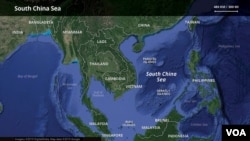Malaysia and Vietnam intend to sign a memorandum of understanding that experts say could eventually help ease a decades-old, six-party dispute over sovereignty in the resource-rich South China Sea.
Maritime law enforcement agencies from the two Southeast Asian countries aim to sign the memo this year and resolve at least 15 years of trouble over the movement of Vietnamese fishing vessels, the official Bernama news agency in Malaysia reported in early April. Bernama quoted the Malaysian Maritime Enforcement Agency director-general saying he's confident the deal, now in its final stages, will solve the issue of Vietnamese fishing boats that enter Malaysian-claimed waters.
Vietnamese boats are known for fishing in waters off the peninsular Malaysian east coast, leading Malaysian authorities to detain 748 vessels and 7,203 Vietnamese crew members from 2006 through 2019, Malaysia’s Foreign Affairs Ministry says on its website. The ministry calls the “encroachments” a violation of Malaysia’s sovereignty.
If the memo helps both sides, their cooperation could eventually go deeper and enable them to resist the sea's militarily strongest claimant, China -- or work alongside it -- some analysts believe. Deals to date call for joint use of parts of the sea, set up joint crime-fighting mechanisms and, in one case, require China to delineate its maritime boundary.
'No other options but to cooperate'
Brunei, the Philippines and Taiwan claim all or parts of the same 3.5 million-square-kilometer sea. Indonesia chafes with China over the waterways’ southern reaches.
“If Vietnam, Malaysia, the Philippines and Indonesia can work together, then at that time China will have no other options but to cooperate with these Southeast Asian claimants,” said Nguyen Thanh Trung, Center for International Studies director at University of Social Sciences and Humanities in Ho Chi Minh City.
China alarms the other governments by landfilling small islets for airstrips and hangars. Its fishing fleets, survey vessels and coast guard ships periodically enter waters claimed by the Southeast Asian states. Beijing rejected a 2016 ruling by the Permanent Court of Arbitration at the Hague. against the legal basis for its claims and has been unable to agree on a maritime code of conduct with the 10-member Association of Southeast Asian Nations, which includes four South China Sea claimants.
A Malaysia-Vietnam memorandum should serve as a “role model” for other deals between South China Sea claimants, said Alexander Vuving, a professor at the Daniel K. Inouye Asia-Pacific Center for Security Studies in Hawaii.
“This would be a very good steppingstone to more cooperation between Vietnam and Malaysia on the maritime domain,” Vuving said.
Fishing a sticking point
Agreements around the South China Sea are few today but have a record of building trust by solving local problems even as the wider sovereignty issue lingers.
Analysts believe the Vietnam-Malaysia memorandum would start by easing tension between Vietnam and Malaysia. Vietnamese fishing boats end up in Malaysian waters because the waters are close, not always clearly marked on maps and offer more fish than the seas nearer Vietnam.
Fishing has become a sticking point for both countries, said Shariman Lockman, senior foreign policy and security studies analyst with the Institute of Strategic and International Studies in Malaysia. Malaysian authorities said in August a Vietnamese fisherman had been shot to death during a confrontation over the location of his vessel.
“The Vietnamese fishing fleets, in search of stocks, they come south, so this [reported memo] is one way to regulate it. It’s becoming a real irritant in the bilateral relationship,” Lockman said. “When people in Malaysia talk about problems in the South China Sea, I think they tend to speak about China and Vietnam almost in the same breath.”
China and Vietnam have abided since 2000 by a boundary demarcation in the Gulf of Tonkin, which extends along both Vietnamese and Chinese coastline and is one of the few places where Beijing has clarified the extent of its sovereignty. China uses a nine-dash line to delineate the remaining claim to about 90% of the South China Sea. China and Vietnam agreed in the same year to a joint Gulf of Tonkin fishing mechanism.
Authorities from Indonesia, Malaysia and the Philippines agreed in 2017 to pool naval personnel who could track Islamic militants who had taken advantage of porous sea borders in waters near their coastlines.
In 2009, Malaysia and Vietnam together sent to the United Nations Commission on the Limits of the Continental Shelf documents showing the extent of their South China Sea continental shelves.
Their submission irked China but “forced claimant states to gradually clarify their positions on the legal status of features and the limits of their claims in the South China Sea,” Nguyen Hong Thao, associate professor of international law at the National University of Hanoi, wrote in a commentary this month.
Any subsequent upgrade to the Vietnam-Malaysia memorandum would avoid content offensive to China, Lockman said. Vietnam regularly speaks out against Chinese activity in the disputed sea, but Malaysia keeps quieter. China is its biggest trading partner and top source of investment.









